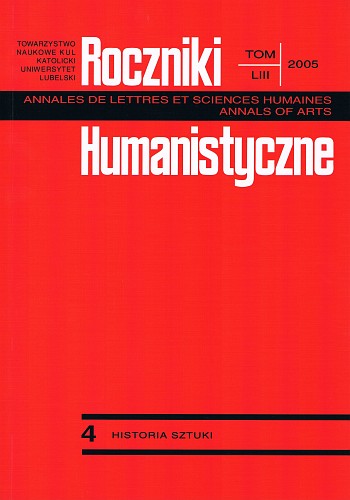Miniatura przedstawiająca Matkę Boską Apokaliptyczną z Mszału kolegiaty kieleckiej.
The Miniature Presenting Apocalyptic Holy Mother from Collegiate Missal of Kielce
Author(s): Matylda PtakSubject(s): Fine Arts / Performing Arts, Visual Arts
Published by: Towarzystwo Naukowe KUL & Katolicki Uniwersytet Lubelski Jana Pawła II
Keywords: gothic małopolski miniature painting; Co llegiate of Kielce; Missal; Apoliptical Madonna; Pontifical Master of bishop Fryderyk Jagiellończyk
Summary/Abstract: The miniature depicting Holy Mother and Child upon a c re scen t (measures: 7cm height x 6,5 cm width) is situated on a 326th sheet of a Collegiate Missal of Kielce (currently held in the Vault of a Kielce cathedral, bereft of signature). The illumination dates back to the end o f XV century, and the authorship is being attributed to a krakovian Pontifical Master of bishop Fryderyk Jagiellończyk.The miniature its elf is a very valuable artifact by both artistical and iconographical means. It was attached to the graphical trend, characteristic of g othic book painting widely spread in Małopolska in the period 1490-1505. It also displays a vast influence of south-german woodcut o f the end of XV century. This influence can be observed in (the archetypical characters and) the technique of the Master used by the illuminator, which emphasize the very traits of a graphic medium.Collegiate Missal of Kielce miniature, draws attention due to it’s interesting iconographical concept. The key to the recognition of Madonna of Kielce as Ap ocaliptical, is a crescent lying by Her feet.The „half-figure ” frame technique of presentation used here differs from a classical wholefigure ’ative, and in the same time is an example of reduction of a tributes - we can see only a crescent, without glorious beams of light nor a crown on Her head. This „half-figure” painting convention used in Holy Mother and Child upon a crescent, had been known and widely used in german graphics of the XV century. Such iconographic form widespread by graphic has gained a great popularity especially in krakovian woodcut of the 1-st. period of XV century.
Journal: Roczniki Humanistyczne
- Issue Year: 53/2005
- Issue No: 04
- Page Range: 113-130
- Page Count: 18
- Language: Polish

